|
Detail - The Censor / La censure - Graphite - 28" x 12" - 1984 - Private Collection Victimhood obsession In the 21st century, we cannot get enough of heroic victimhood. It seems to enhance the sharing we do on Facebook with our stranger-friends. - a meting out which, at times, appears to be more tantalizing than our daily fare of anniversaries and accomplishments. But If social media is our new forum for the sharing of pain and sadness, among pics of kitties and kids, we are nonetheless selective : a bit of our own mental health issues and a lot of that of others. And the victims we most love to hate and hate to love appear to be those we consider "above" our station - i.e. : those who tend to be seen to be "more" than we are. A reflection of this evident "obsession du jour", is the infatuated romanticizing of the mental health of “creatives”. How is it that the lives of movie stars, painters and writers so fascinate us? Is it part of our contemporary love-hate relationship with the “elitist” cohort - those who shine - and, in so doing, make us feel small because they are, (in our minds, at least), so much bigger - which triggers either extreme left or right "idées fixes" in their regard? A prime example of our disproportionate interest in the lives and foibles of the notorious are the numerous headline grabbing online discussions, readings, videos and now recent movies on Van Gogh. In their quest to illuminate, they all show a tendency to mainly focus on his "disturbances" - what with his ear slicing flirtations and his "surely", "must have been", "possibly and probably was" suicide. Add to this a rusty gun's been found and displayed in a museum as "most probably" THE gun. . . And we now know his purported bar-maid girl-friend's name and the "kid's" name who "may or may not" have shot him in the field where he was painting. That being said. . . Is there a hint in the wind that we consumer's have had our fill with Vincent? Is it all getting a bit stale? After so many years regaling in his popularity, are we tiring of him? Seems so. . . Public reactions to the latest offerings are slim. Maybe, as with Doritos regular, we're bored and need a new and improved spicy brand. . . In essence, we now know more of nothing about Vincent Van Gogh than we did before we got all hot and bothered with his mental health issues eons ago. Had we remained entranced with his artworks rather than his sliced ear, possibly we would have learned of compassion and empathy rather than sympathizing and identifying. Possibly we would have discovered the wondrousness of his soothing colours and the calming effects of his landscape compositions and the inspiring pathos of feelings he displayed in his human subjects. Possibly we could have integrated within our own souls the strengths inherent in Vincent Van Gogh's actual "beingness" : achievement despite the pain. Possibly we would have learned more of the heroic combatant that he was than so much innuendo about the submissive sufferer that he purportedly was. But then, maybe we prefer our illusions, our romantic notions to the truth. Focusing on what was known to be and are real : his genius in paint and story-telling - would only lead us to shockingly surmise that he might have been saner than we are - more prone to fighting his demons than submitting to them. What Vincent did best was paint. And through his paintings he told the truth both about himself and of the world. But then, such considerations are not entertainment fodder. And so we've preferred eviscerating most of him, And now, with so very little left to stab at, we move on, it seems. So, where to now? Instant gratification times demand instant gratification variations. . . On the heels of our increasingly lessening interest in Van Gogh, conveniently rises yet another (even greater?) bad boy. His name is Michelangelo Merisi da Caravaggio - and to his multi-million new friends that we all will be soon, he's simply called : Caravaggio. His artwork is super powerful and was considered shocking in its time. It's even spotlit in its precocious presentation of reality. The drama within is blatantly in our face and the compositions and subjects earthy and even crass to those habituated to the saccharin holiness and purity of the late 16th and early 17th centuries. We definitely could learn to hate to love Caravaggio for sure! . . Why? Because this new attraction on the titillation horizon has secrets and behaviours not in keeping with a painter of spiritual symbolism and religiosity. His is a mercurial connection with the world. He's perfect as a Van Gogh romantic hero replacement. He seems to have been more strong willed, more deliberate in his actions. His life teamed with sin and suffering. He was a self-serving aggressive figure - a subject for both reviling and admiration. And so, as a new and improved obsession, he fits the mold to a T. New side-show freaks must always provide an increased tension, an exponential component to them in order to fill the space left vacant by a former fixation. Caravaggio is known to have been a murderous hot head, was he not? Yet, he painted oh so sensually! Did he also kill sensually? Did one provoke the other? Did he paint to arouse or was his work his own arousal mechanism? Ooooh! Titillating! . . . Tell us more! No, no, no! Not about his paintings!!! (We've seen one, we've seen them all!) What of his "tendencies"! Let's make him (at least for now) our latest victim of "maybes", "possiblys", "could bes" and mythical circumstances and propensities. Why not? He's just another dead man from far off times and places to denigrate for our discussing pleasure?. . . Oh my! He had a really rough childhood too!!!!!!. That is such a fun beginning!!! And so it is as articles begin appearing in "art mags" and online blogs : More savage than Caravaggio: the woman who took revenge in oil - Jonathan Jones - 05- 10-16 - The Guardian Caravaggio's ‘assassin’ finally revealed four centuries after his mysterious death at 38 Published time: 20 Sep, 2018 - RT Renaissance Master Caravaggio Didn't Die of Syphilis, but of Sepsis - By Laura Geggel - September 28, 2018 - Live Science Sometimes our fascinations say more about us than about those at whom we point a finger. And so, I repeat, Caravaggio, is fast becoming "our novelty du jour". Oddly, with imaginations easily gone wild as our world is wont to do, it's a wonder most of us are not the renowned anointed "artists" and these poor schmucks we dig into the recalcitrant nobodies. That being said. . . Caravaggio, so it is recorded, was brought to trial more than 11 times (mostly for silly stuff). But then who cares. He actually got arrested!!!! We like that. John Ruskin, the art critic - sounding like one of us, sneered at Caravaggio's "vulgarity, dullness, and impiety". He stabbed at him with impunity only 200 or so years after Caravaggio's death. How daring! How sad he was without the wide-afield capacities of Facebook! Fast forward into the 21st century. . . : "Not a month goes by without a sensational discovery about Caravaggio appearing in yet another headline." (The Art Tribune - Didier Rykner, 2010) And so the story "grows". A field of intrigue, discredit and envy In the arts, it is the "fate" of those who dare be "in it" to be celebrated in the beginning of one century, and not a decade after, be castigated. Limited "lovability" in the visual arts is par for the course. Ironically, this more often than not occurs as a result of the unpredictability of our ever "newer and improved" populist hate-love contentions and not because of the quality of an artist's work. But then, amateurs investigating "this one's" propensity to blow up, that one's gender-bending, that other's inversions or his/her anti-social behaviour doesn't help matters in the area of objective "historic" considerations. Ironically, it's not the paradox of the likes of Caravaggio which should intrigue us but rather the miracle of the enigmas and mesmerizing compositions in the artworks presented by him and the likes of him. But then, again, who cares about artworks after discovering the juicy bits? The value of disassociation - the creator is not the artwork When “visiting” a painter, I personally need to comfortably disassociate myself form his/her creator persona. I want the man/woman to step away - to let me read the book before me in peace, to scan the painting, to feel the sculpture without interference. I want the work to be “served up” on a silver platter- alone in all its want-to-be lusciousness and glory. That is a viewer's role - to receive artwork and to be mesmerized by it, or not. But for that to be, artwork must be “mature” - ripe, ready for the tasting. Professionals are aware of this. They know that beyond the last brush stroke they have nothing else to say - though they may want to. But at that point in the game, the only role a creator has is to be the silent servant, the "bowing to a viewer and 2 step back” presenter of artwork to be scrutinized for its ultimate gift of "art" - if art be within at all. In the end, it is always up to the completed work to start the conversation by simply standing before the critical eye of an observer - where silence and nothing more emanating from a product presented is an assured death knell. The fading of notoriety Why would I even need to consider the creator of an artwork when I am scanning for the mystery hopefully to be found within a newly created artwork? Hell. If I want superficial thrills; if I need gawk at the artist more than I need look at his/her work, I should take a tour of homes in Hollywood and get my envious voyeur kicks there amidst a busload of "likes" (no pun intended). Basically, an artist's role (if one is lucky enough to reach such a status in a contemporary arena filled mainly with visual art technicians) is grandiose but fleeting. Success is not in the doing (except for the practitioner). For the rest of us, it's in the "fact" of all of that creative élan - the "product" of it. And for an ever more limited fewer, the essence within it which calls out to us - the art emerging from that product which seeks to speak, to reach out, to touch and move us. But then, that discovery is after the fact of conceptualization and process. Beyond that, notoriety stands (maybe) shines (possibly) and fades (always). And those in the field know it. Their role, despite it all, is simply to create, nothing more. And if history and social media are kind, those makers of artworks may "eventually" be recalled from their imposed purgatory and, just maybe, remembered as the wondrous enigma magicians of timeless time that they should always have been considered to be from day one. But what about me, the all important viewer? As a viewer and appreciator of artwork it isn't in my purview to tell others what they should do, could do, might do, possibly can do sitting before an artwork's possibilities. I can only say what I do. As an amateur (in the classical sense of the word), I want to see the paint and texture and composition and design and the whole structure of the piece. I want to discover the composition through its blending of elements. In the end, the artwork must be open to telling me the story it has been created to tell - be it representational, abstract or non-representational. I want the painting to speak and the creator of it to shut up. In that position of “exigeance” I may rediscover the author - or not. Therein lies the possibility of knowing the essence of the creative soul of the artist; the cells making up his/her genius. But I don’t want to see those cells physically, mentally or emotionally human in my mind’s eye. They must be part of the mystery of the creation I am taking in, or they are not. I want to see the mastery, the miracle, the enigma in/of the work, not the foibles which cause populist inflections such as : “How in hell can this type of crazy guy do this type of wondrous work?” In essence, we don’t have to like or to understand the personality or persona of a painter in order to be mesmerized or to be awed by their work. It's a bit like acting. The best acting is done by those who in the process of presenting their character - disappear. They become the character who obliterates the act of acting - since, at this point, the character's exponential presence annuls the presence of the artist. . . THAT is acting, that is painting, that is sculpting and dance and writing and singing. All we should want to see in artwork before us is the statement made, a presentation of itself in all of its blatant nude, glorious, sensual, aggressive and/or gentle powers. Creating is the art of a process which elevates a virtual reality to reality. Creating is a concept come to life as a mystery, an enigma. Art therefore is felt. It is sensual, not logical. It is tactile, appealing to the gut. As artwork is the product - the vessel, Art is the contained mystery to be revealed from within. Speak, or forever. . . . That it SPEAK is what I want form artwork - to tell me that it is worthy of bearing the “art” which (if it is there) will emerge to mesmerize me. Yet, for this to be, we must accept that Art is an extreme rarity - no matter that we call everything art today. Art, as a consequence of excellence and enigma, is the greatest symbol of man's capacity to shine and, as such, it is therefore above and beyond the person creating the work from which it may emerge and the "made container" in which it can be found. For example, The most recent adaptation of Madama Butterfly was recently presented at the Teatro La Fenice in Venice. Expecting nothing special (it being a contemporary version of the original), the discovery of it was stunning, astonishing, overwhelming. What a wondrous production! Did I want to know who designed the set, the costumes and the adapted story line? Yes! Did I want to dissect their personas? No! I got what I wanted: the awe-inspiring nature of the beast - the artwork become art. If tears are any matter of proof, they flowed freely. In essence, I have never stood before artwork wanting it to be less than it is - i.e. : yet another of the billions of “artworks” out there - efforts striving so intensely to be more than simply paint and canvas, stone, wood, dance, music or sketch. In the end, some make it. Some don’t. But by that time of discovery or non-discovery, the artist (if he or she is so) is already back in the studio creating yet another "stab" at a statement - because an artist never tries to outshine the vessel from which art may emerge or the art that eventually does. And an artist never assumes, never presumes that everything he or she "makes" is art. But what of the wondrousness of the heart and soul and mental angst and emotional status in being an artist? For all intents and purposes (and I am repeating myself) I don’t give a sweet damn what the mental health issues were/are of a painter - or what their perceived flaws purportedly are - or posthumously are deemed to have been. Artworks - as they relate to the visual arts universal mandate of sharing - are created despite pain and suffering and not because of it - Their purposeful possibilities lie in the "to be shared with the world" universal mandate we impose upon ourselves in that realm. Side bar (Note: This does not preclude the value of art therapy wherein individuals create artworks for their own personal needs - where they are speaking to themselves therapeutically and not to the world. This is a highly legitimate and valued healing practice. But even art therapy is not always limited to a sole purpose - wherein the message conveyed may not only be a healing consideration for the "self". When artwork reaches beyond the self in a display of universal therapeutic messaging, it is no longer only therapeutic - it takes on a perspective which reaches beyond the pain and suffering expressed in a single soul and renders itself open to the understanding of that ache as universal. In essence, some art therapy expressions, due to the talented intervention of their creator, are of value not only to the individual but to the world. Prime examples of personal angst of universal consequence works are those of Munch and Egon Schiele - among others.) Insinuations vs analysis But to link an "insinuated flaw" or mental health issue as muse or catalyst to genius is ludicrous. There is a sober difference between the perception that someone is "a mentally unhealthy artist" and an artist who happens to suffer from mental health issues. The former predetermines the artwork created is dependent on the issues themselves and the latter despite those issues. Reading Dr. Judith Schlesinger's well documented book: "The Insanity Hoax" is to become seriously informed and less emotional and reaction-laden on this misleading assumption of "mad artistry". Dr. Schlesinger's latest presentation at a symposium of experts at the Van Gogh Museum in Amsterdam (2016) was so well received that the final determination re Van Gogh's mental heath was certainly in part based on her research. The finding? : Van Gogh was NOT crazy! Despite emotional cries to the heavens by some who need him to be so, experts at a 2016 symposium at the Van Gogh Museum in Amsterdam determined otherwise. A good read summary is available at this address : http://www.creativitypost.com/arts/no_van_gogh_was_not_crazy Demon speculations and determinations In Venice, my wife and I spent 4 and a half hours visiting with Tintoretto, Bosch and Veronese masterpieces. We so enjoyed our visit, we forgot about ourselves, about time, about the purported personalities of the creators and only focused on the creative genius before us, which - when not interfered with via our own thoughts on the artist, was most evident and not in need of redefining, explaining or revisioning. Why? Because the evidence of what was there before us was enough to open the door to whatever it was of the artist that either of us needed to know. The rest, if pretending to be of any concern, related more to an errant need to pry than to any truth or fact. What needs be universal is that creators "make" despite and not because of their supposed blemishes. And if this be so. . . What, then, becomes the purpose of our arousals at discussing someone else's demons? If a logical sociological and/or psychological premise is that all of us are, in one form or another, flawed" what is the purpose of populist speculation on an individual's "pointed at zits" other than to "bring those individuals back "down" to "our level" of feeling lesser? When someone offers up the best they can be today and that best seems to be over and above any best possible anywhere else at that time - this is enough to know about a creator and even of the world. If we knew what it was to be an artist we would know that the maker never competes with his/her creation for attention. Only a fool would do that. Artwork becomes art when the artist takes 2 steps back to allow the creation to speak on its own - to independently do what it was created to do : reach out and touch and move and take viewers in. There is no more “knowing” than that required when it comes to a creator of artworks. If we need more, we are either historians on the take for a story or voyeurs in need of a populist fix. Only we can determine the facts of that statement. Generalized narcissism in need of a fix Contemporary narcissism has fixated us on Van Gogh’s mental health - not Van Gogh the man and even less the phenomenal incredibleness of his artwork - from which so much ART has emerged - and this from the soul of one individual. No. . . From awe-inspiring creator of wondrously bright and engaging images, he has become for our century nothing more than "a thing", a side-show subject bandied about in an era of nothingness wishing itself to be something - and finding no other solution than to belittle in order to rise up from the muck we so often wallow in. And because he became a fixation, we lost "him" and his genius in the process - as we will eventually lose Caravaggio. When we begin to see artworks as nothing more than results of expressed turmoil - rather than a powerful stance against the demons that assailed their creator, we are the ones who fail in our status as human beings. Fixating on Vincent the depressive became a lucrative industry which turned this brave man (admittedly with issues) into a side-show freak. Ours will be remembered as the time which ripped from him his essence - the genius of it - the genius of him. And this for the simple purpose of meeting the needs of our own obsessions and the reality TV drama we believe to be "the very truth" of our own lives? In summary, I can only ask myself 2 questions: Is our interest in artists of the ilk of Van Gogh and Caravaggio simply a craving to have those who succeed served up on an altar of sacrifice - for their daring to be great? Or/And. . . Is our incessant scrutiny of their mental health a reflection of the denials we hold up before our own mirrors?
Comments
Oldsmobile-88 - 1952 - My baby "tank". Drove her everywhere and had great runs down the highway to cottage country. Searching for new archiving/cataloguing software is NOT EASY!. . . There’s lots to peruse out there - and they’re all different one from the other - if not equally as useful as they say they are. I therefore leave you with a 2018 (pre-Xmas) parting gift. . . one which may make your life easier if and when you too are in the market for software which can efficiently and easily catalogue everything we have done over years of creating artwork. So. . . What’s out there that calls itself Art Studio or Artist Management and/or Artwork Cataloguing software? Do we even need it? All of the info presented stems from the fact I am old (er) and am therefore interested in making sure I can track or (at least) try to remember all of the artworks I have created over the past 50 years. Why? In essence we, in the visual art world, still recognize that what we do (did) is who we are (were) and what we will be remembered for (if at all). :) Inventory, management, archiving, provenance. . . All of these things mean something to a visual artist when suddenly they discover (remember) that they are finite and their artwork is, possibly, not. . . But for me archiving is about archiving - not promotion, advertising, sales, business practices, taxation or invoicing. It’s not about the multi millions we are collecting every month from the immense number of sales we are experiencing. There are small business apps and concomitant accountants for those. I need a clean list of all of the artwork I have ever created along with all of the pertinent and even intimate information regarding those artworks. That there be sections in which a basic overseeing of sales and contacts are presented in a software is par for the course. But that additional information should be more in keeping with documentation than marketing. That being said, there is a lot of software (apps or programs) out there which purports to offer a lot for your money in the area of artwork inventory management. And it more often than not is exactly that : inventory management software. . . And that means some programs are good, some bad, some iffy, some amateurish and a few professional. It’s up to us to make up our mind as to what category we attach any of these products of ours to. What others (critics, historians and loved-ones alike) will do with all of this gathered information in the future is their business. We won’t be around to worry about our legacy or how it will be (mis)handled. . . (For that we may need a hard-a. . . lawyer!) Ha! Nonetheless, what we leave behind should at least be presented in a professional rather than amateur manner. Our lives lived are only as valuable as how well we choose to present our “catalogue raisonné” to the world after we are gone. That being said, when we have more than 3000 artworks in our lifetime to catalogue. losing the ability to access or add to the information we need (during our lifetime) is serious business. Anomalies and/or falsehoods are difficult to correct after the fact. Past idiocies. . . Being more obsessed now than I was in my 20s and 30s (when I simply ignored cataloguing and sorting or even photographing (!!!!) my works. . .) I’ve come to realize that growing up is often a series of procrastinations gone wild leading to a hectic race to the end for “order” And so. . . . about 20 years ago I finally began cataloguing in earnest. But how do we catalogue? Well, there is software out there - for the Mac, for the PC. A pencil with pink pearl eraser or a smudgy ball-point pen sketching out our life-lines in a “scribbler” is passé. There are downloadable apps now along with cloud based services available. But as usual in this marketing frenzy world, some of these offerings are excellent, some Are serious tries at being of value, some are amateurish and some ridiculous or overly complex in their tries to be professional. From what I have discovered, the really “good stuff” is rather simple, logical, and informative. Like a good wall, they disappear into the background when you insert our work into them - allowing our work to shine. Some of today’s offerings are over-zealous in the design element category - often “over window-dressed” as in : they wear “too much make-up” and display too little legitimate content to be of any archival value. I’ve reviewed a few programs over the years - tested several, used some and dumped others immediately. The following is a personal commentary on what I have looked at, used and finally ended up with (most recently). I’m not out to knock any “rejected” or ignored software as much as I am out to select the right one for me. And after 50+ years in this business, “me thinks my opinions are worthy of some consideration”. And when did I ever back down anyway? :) Why did I change software along the way? What with the trouble of transferring everything to a new archival venue? (1) I’m fussy. . . If you can’t serve my needs, I’m gone. (2) Unlike pencils and ball-points, some of the software offered “becomes” no longer functional because it is (for some reason or another) no longer updated or upgraded by its creators or owners. Therefore these apps simply stop working when they encounter an environment (operating system or OS) which, to stay pertinent itself, is always being updated and upgraded. Note: Regardless of my choice, I’m more than agreeable to discuss or argue a point that needs to be made in regards to the archiving artworks provided in this comment piece. So why catalogue? The main purpose of art studio software should revolve around 2 critical points : (1) It must have organized “filing of concrete evidence of artworks created along with related information” storage capabilities. (2) It must provide a page (s) of varied fields covering the provenance (ongoing life history and “travelogue” of an artwork). (1) Organization allows us to review and add to data re: the artwork we have created throughout our years spent as painters and sculptors, etc. (2) Provenance legitimizes our work and provides information which proves the artwork created is ours and not someone else’s. We live in a world of fake news. So let’s make sure our artworks are not perceived to be or have been “fake”. ALSO : An artwork catalogue worth its weight in gold will have room for note-taking which, for all intents and purposes, speaks to our life and history as the creators that we have been and continue to be. That being said, archiving is also about you and “moi” along with it being about our artworks. It describes the “what and who” that went into the “what” that we have created. Nonetheless, not all that is available out there as artwork cataloguing or archival software knows what it is supposed to be. . . Most seem too intently designed to be everything to everyone and, other than being pretty, end up being pretty useless as a respectable recognition of our passing through the “art” world. Some are more inventory-control and selling list oriented apps. Too many offer too much“bells and whistly” stuff & end up being annoying & time consuming wastes. Personal biases. Cloud versus downloadable app : Cloud : I remain seriously wary of cloud based services. If anything screws up in the area of information gathering and “holding”. . . I need to remain the most responsible person for a “disappearance” screw-up. In the cloud, I am not. Losing control of who and what manages the content whereabouts and details of the “stuff” I have created and worked on all of my life is a non sequitur to the deep personal involvement of creating it. And so, for now, I’ll leave cloud recognition to perceiving puppydog faces and rabbit ears as misty clouds float by while I chew on a blade of grass in a farmer’s field whilst looking up to a cobalt blue sky. (Lord I am no poet. . . .) Desktop Based Applications: That I have the data on my computer makes me responsible (stuck with) the quality of my care-giving abilities. Is it more complex to handle? Certainly! Life is not a series of fun and easy wishings, despite what advertisers sell us. Do I back up regularly? That should be my concern - not that of some faceless cloud service where everything we “own” can and may evaporate - at least as it relates to our own personal paranoia. Again, being professional demands we be responsible - not numbed or dumbed down by some virtual reality app that promises me it will take care of business - and NEVER lose “my stuff” somewhere in the stratosphere of some pixelated parameter. Now that my personal opinions have been clearly laid out. . . . . . . What have I seen and been mesmerized by (or not) over the past year?: And how do I judge what I have encountered? : Review characteristics found within the table below : (Note: I work on a PC therefore there is little info re Mac computers.) • Cloud or download : Into which category does this product fit? • Levels : Is this product for Pros or for Newbies? I am not being derogatory - comments are based on perceived purpose and design • Support focus and availability : Comments pro and con Note : Anywhere a question mark (?) is indicated it simply means I do not know. It does not mean the product is questionable • Service Cost : • $ indicates Inexpensive • $$ = More expensive • $$$ = Expensive BUT reasonable for the quality presented • $$$$ - VERY expensive for what is being offered (in my estimation) Cloud Based Services : Downloadable Desktop Services : For those of us with tons of money. . . additional offerings are not listed (whether cloud or desktop based). Why? They are simply in the $$$$$$$ range and are irrelevant to us who are simply seeking a catalogue or archiving service. Historical Perspective: For 10+ years I used Working Artist. It was a VERY professional software with the “artistic” interests of the information gatherer in mind more than that of the “sales gatherer’s” perspective. Yet Working Artist did cover all of the bases and more in all areas and more. Why did I abandon it? It abandoned me. . . All of a sudden, its website disappeared - simply indicating that it was moving to another service provider. That info is still up and running as we speak - after a year and more. . . The support service no longer responds to queries or other emails and updates and upgrades have not been forthcoming. What with the new Windows 10. . . That is not acceptable. And since, the program on my main computer has stopped working completely - despite the best efforts of my tech specialist. Luckily it still works (for now) on my laptop. I need it to still function. As it is the template from which I am trying to transfer 50 + years of artwork info to a new (compatible with Windows 10) archiving software. And so. . . I present to you the latest and greatest 2 discoveries “for me” : Artist Organizer Pro and Chaos Intellect. They both have superb qualities as apps.
t may not seem like much to the naked eye. But let's take a deeper look: Chaos Intellect offers up a full page of adaptable options - 17 to be exact Each of these options (fields) allows us to create our own personalized archiving system - including usual single subject, editable drop down lists & others to be used for sales and discounts, currency variations, % and calendars for sale dates and donation dates, etc. Every aspect of archiving is possible with Intellect. It has a notes section which permits client, artwork and provenance information- everything we need to archive data on our artwork. See chart 2 below which displays my choices for the 17 editable fields and how they were applied to one specific artwork.: I chose to stick with the basics and clarity. The main project page (now changed to the "Archive" page) - (because that is also adaptable to individual taste and needs) has the editable fields on its main page. Included in the top list of services are: also "categories" which means that different aspects of the fields displayed can be categorized for easy search and classification. File shortcuts means each artwork can be connected with the image files and folders and other data which visually define the artworks described on the page. Then there is the appointments tab which describes activities related to the artwork and the buyer or client, tasks can be anything we want them to be -especially in relation to exhibitions and consignments, etc. E-mail shows the easily accessible emails related to the artwork in question and finally the most incredible aspect of Chaos and Intellect used as archiving software: "linked contacts". These are the names linked with the artwork in whatever form we need them to be involved - for advertising, sales, announcements, etc. This means we have ALL of the information AND contact possibilities related to clients, patrons, agents, galleries, etc, etc, etc. Anyone related to this specific artwork can be contacted directly WITHOUT having to leave this software and go to another App to connect with (or connect information to) a related client or potential client. IT'S ALL THERE at our finger tips. Below, check out the artworks list of each page. Additionally, I cannot say enough about the search on this little bit of wondrous software. Basically, what we have is software I have never had difficulty talking about because it always does more than it sets out to do.
I could keep talking on and on about this archiving gem (that was not created to be so) but I'll let you discover it when you visit the site "Chaos Intellect" and download it for yourself. Last but not least. The cost of Chaos Intellect - for its management, contact and other business aspect expertise (and so much more) it becomes the file cabinet of our whole creative output. . . As usual I can't stop thinking of ways it is phenomenal. . . the support services and the solid and constant updating. . . What you get is a small miracle which prices itself at less than any software which prides itself at being "archiving" software . . . . . . $59.95 US. . . . . Note: I have no connection with Chaos Intellect except in the area of having purchased the software many years ago when it was just called "Chaos" and having updated it since. Intellect constantly strives to become better than it is and that is incredible in this day and age of fast sell and quicker get-away which so many of us experience in the purchase of efficiency products. Hope you get to try it. So far I have archived over 2500 artworks with Intellect over the past 2 years. I am so enamoured with what Chaos Intellect offers me in the area of business and contact management (AND most especially Archiving) that I will be MOST pleased to help anyone out there who needs answers in getting Chaos Intellect to work them as archiving software. Can't help but respond to this article with a tongue-in-cheek image of the robot "existence" amongst us. It brought back memories. This drawing "He Did It!" was exhibited at the International Personal Robot Convention held in New Mexico in 1983.
|
Archives
May 2024
Categories
All
|
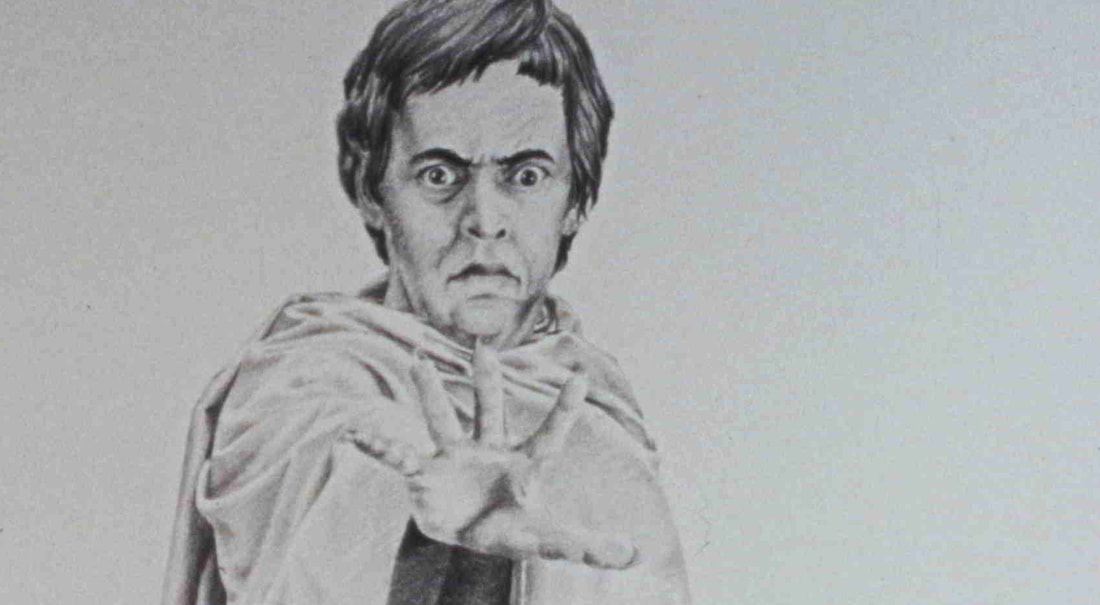
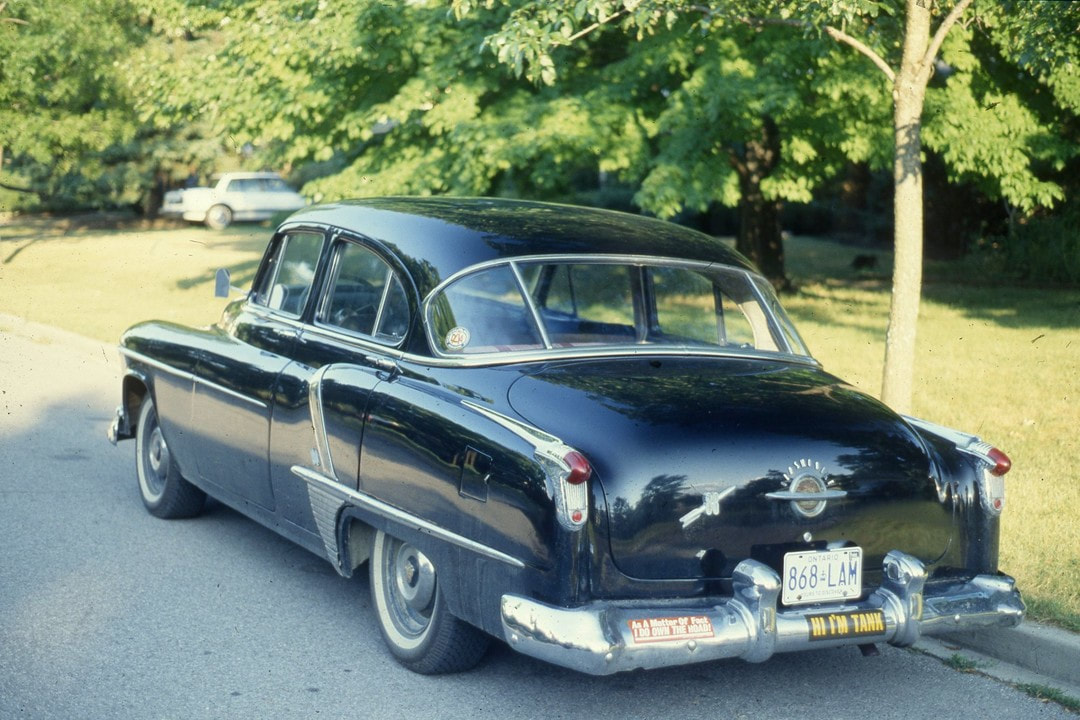
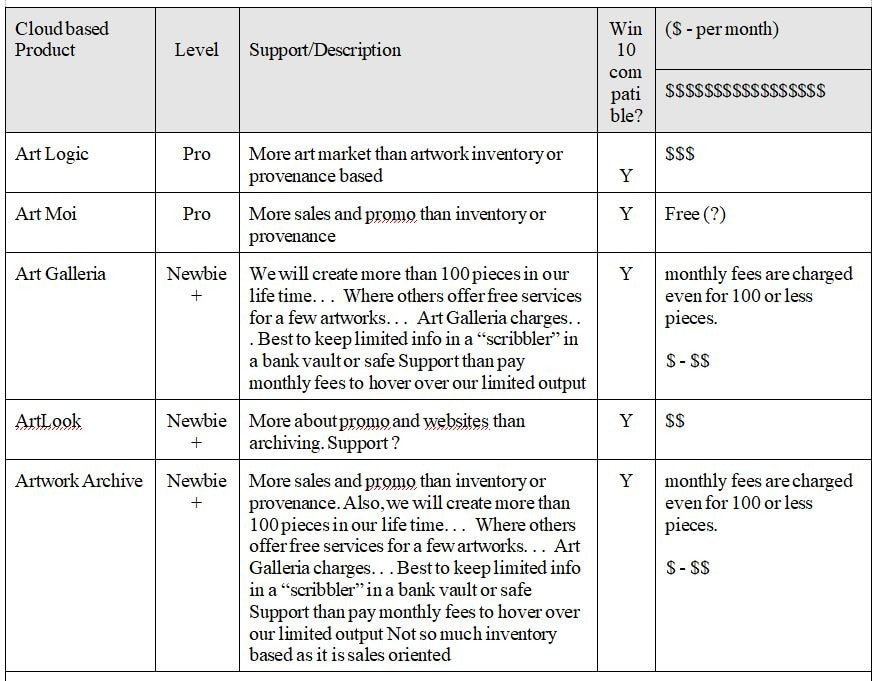
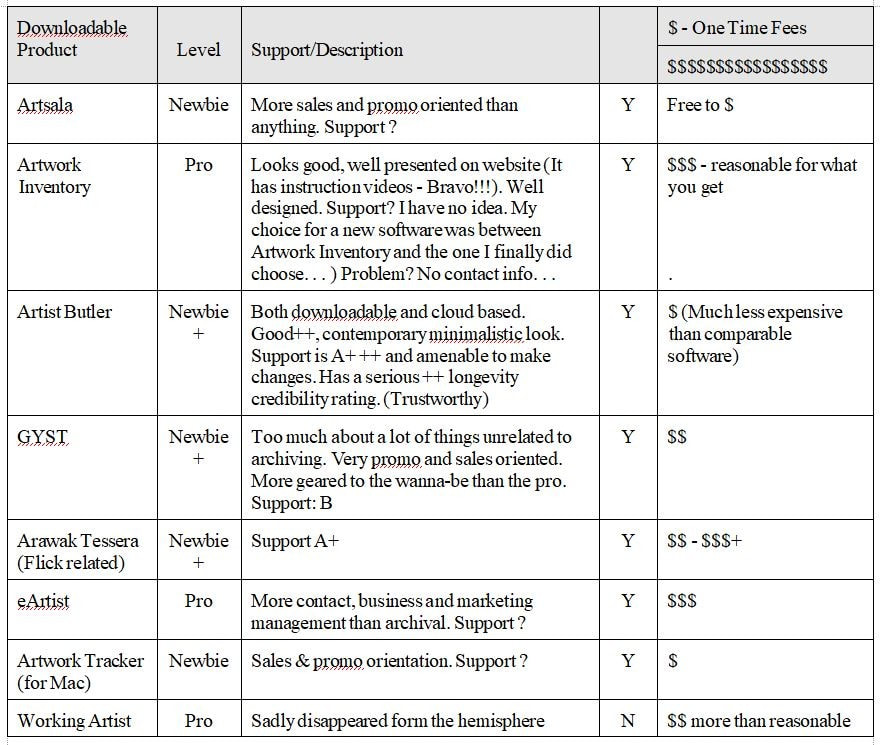


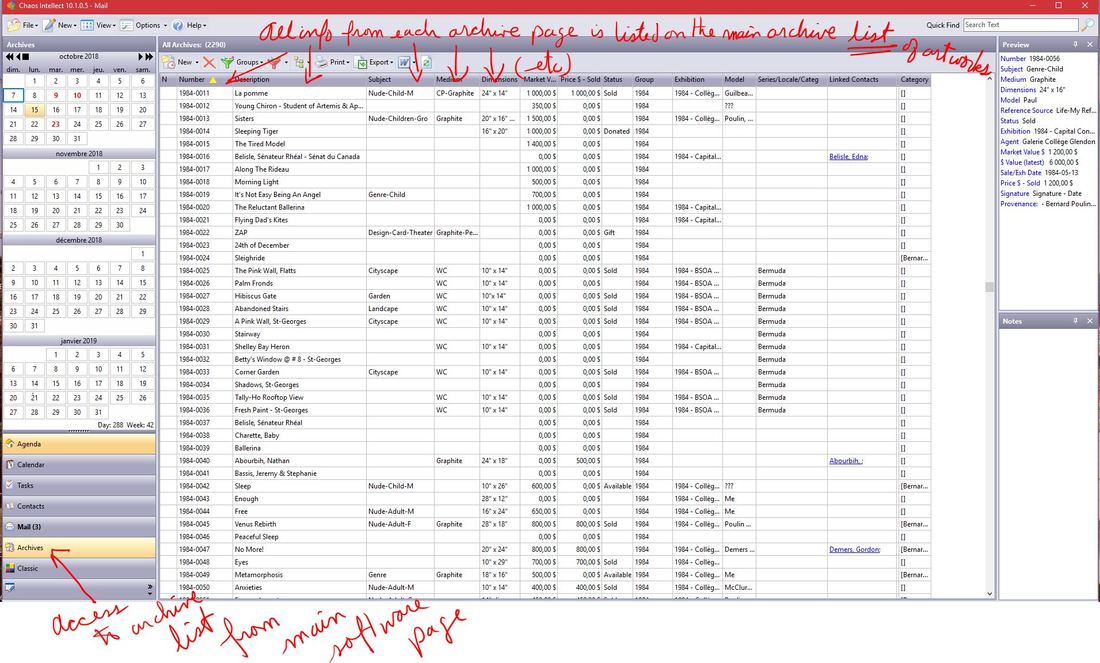
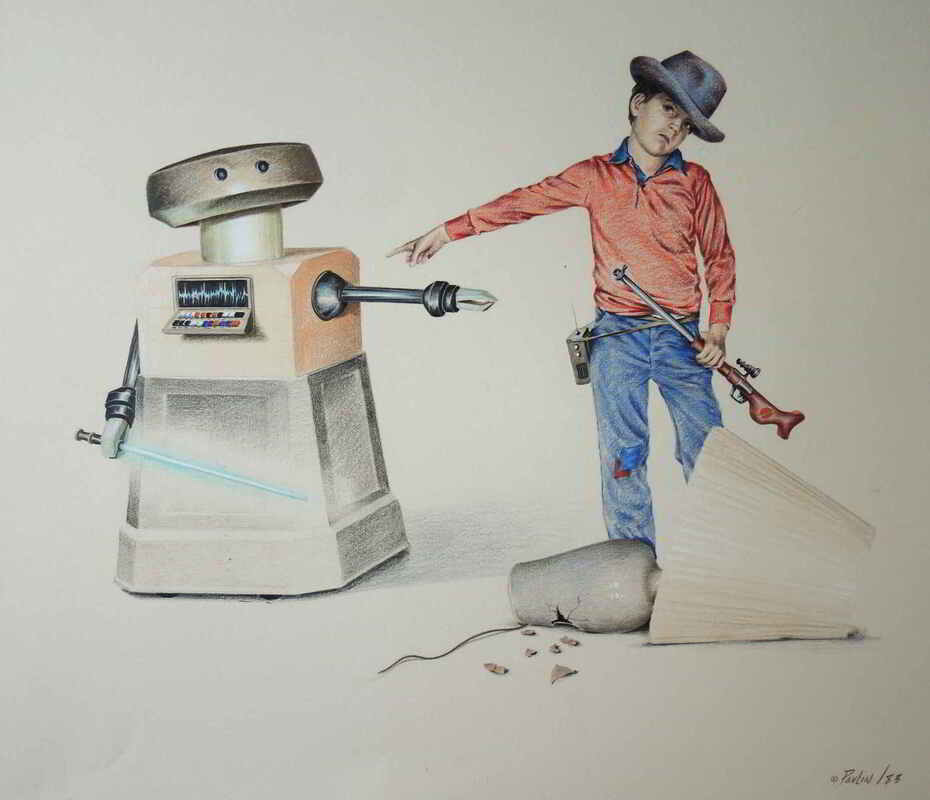
 RSS Feed
RSS Feed